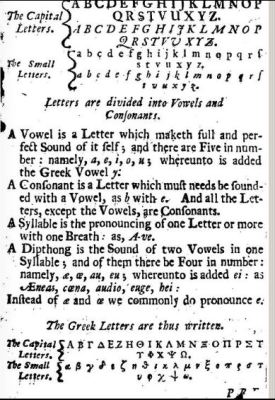Latin was a fundamental part of the learning in any grammar school in the 16th century, and as the name of the school from the beginning indicate; Latin grammar in particular.
Any student who ever entered this kind of school would have encountered it; Lily´s  Grammar, written by William Lily, the first headmaster of St. Paul´s school in London.
Grammar, written by William Lily, the first headmaster of St. Paul´s school in London.
William Lily was born in or around 1468 in Odiham, Hampshire. No much is known about his childhood, and his parents remains, at least to me, anonymous, but at the age of 18 he entered the university of Oxford, allegedly Magdalen College, for studies of the arts. It has been suggested that he chose this college due to the fact that William Grocyn, scholar and supposedly godfather of William Lily, was the reader of divinity at Magdalen College at the time.
In 1488 Grocyn went to Italy to study Greek and Latin, and it may be that this too was an inspiration to William Lily, because after graduating for Oxford he went on a pilgrimage to Jerusalem and upon his travel back to England ended up in Rome, by way of Rhodos. In Rome he attended lectures by the Renaissance humanists Angelo Sabino, Giovanni Sulpizio da Veroli and the controversial, to say the least Guilio Pomponio Leto. From there he continued to Venice to attend further lectures, given by who is unclear.
Upon returning to England, he became one of the first scholars in Greek, together with William Grocyn and Thomas Linacre who founded the Department for Greek Studies at Oxford.
Among his friends, once back in England, could be found, apart from Grocyn and Linacre, Thomas More, Erasmus and John Colet.
William Lily is thought to have been the first to teach Greek in the city of London, first as a private teacher alongside the teaching of grammar. In 1510 John Colet, who was dean of St. Paul´s, founded St Paul´s School, and started searching for a headmaster of the school. His first choice for the position seems to have been Erasmus, who for some reason was not interested. The second choice was William Lily, who started at the school in 1512 and shaped the school into a model of classical studies.
 At some point between his return to England and his acceptance of the position as the first headmaster of St Paul´s School, it is said that William Lily considered becoming a priest, but whether he decided against it because he met Agnes, or he had already chosen another career path when he met her, but marry Agnes he did, and during the 17 years their marriage lasted, they had 15 children together, of whom only two survived their father. Agnes herself died at the age of 37, probably in 1517.
At some point between his return to England and his acceptance of the position as the first headmaster of St Paul´s School, it is said that William Lily considered becoming a priest, but whether he decided against it because he met Agnes, or he had already chosen another career path when he met her, but marry Agnes he did, and during the 17 years their marriage lasted, they had 15 children together, of whom only two survived their father. Agnes herself died at the age of 37, probably in 1517.
But it isn´t primarily for his position as a pioneer for Greek learning that William Lily has come to be remembered. It is for his work “A short introduction to Grammar”, a school book in Latin which came to be in use all the way into the 19th century. The book was instigated by Colet and edited by Erasmus. After William Lily´s death parts were added, and the final result didn´t appear until 1540. In 1542 Henry VIII proclaimed it to be the only book on the subject to be used in grammar schools, and over the decades to follow, it was so widely used that it has a part of its own in four of the plays by William Shakespeare; The Merry Wives of Windsor, Much Ado About Nothing, Titus Andronicus and Henry IV Part I. The book was divided into two parts, the second one being “Brevissima Institutio seu ratio grammaces cognoscendae”, which is believed to have given Shakespeare himself maybe his first contact with poetry, as the book partly consist of the poem “Carmen de Moribus.
He also wrote prose in both Latin and Greek.
William Lily died in 1522, around the age of 54 years. The reason for his death is in some sources suggested to have been the plague, which seems to have taken his wife and several of his children, but others suggest that he died from an operation having gone wrong when trying to remove an inflamed boil.
He was buried in the north churchyard of St Paul´s cathedral, destroyed in the Great Fire in 1666, and his name is among those of the memorial that can now be seen the cathedral.
Sources:
Luminarium Encyclopedia Project
Repertorium Pomponianum
Dictionary of National Biography – Joseph Hirst Lupton
Linacre, Thomas – Dictionary of National Biography/Sidney Lee
Shakespeare and his world/Lily´s Grammar – Prof Jonathan Bate, University of Warwick/Shakespeare Birthplace Trust